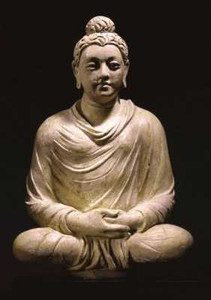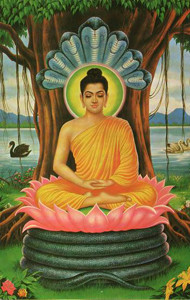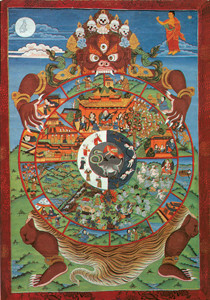Paul Derengowski, ThM
Founder & Origin
 Buddhist beginnings are rooted in the person of Siddhartha Gautama (c. 563-483 B.C.). Siddhartha was born into a relatively well-to-do family, as his family was a prominent member of the Kshatriya caste in India. According to one tradition when Siddhartha was conceived his mother was said to have dreamed about a white elephant, whereby later Siddhartha was born from his mother’s side. Immediately after birth Siddhartha supposedly took several steps and declared that “I have been born to achieve awakening for the good of the world: this is my last birth.”
Buddhist beginnings are rooted in the person of Siddhartha Gautama (c. 563-483 B.C.). Siddhartha was born into a relatively well-to-do family, as his family was a prominent member of the Kshatriya caste in India. According to one tradition when Siddhartha was conceived his mother was said to have dreamed about a white elephant, whereby later Siddhartha was born from his mother’s side. Immediately after birth Siddhartha supposedly took several steps and declared that “I have been born to achieve awakening for the good of the world: this is my last birth.”
During Siddhartha’s youth his mother passed away, leaving his aunt to raise him as her stepchild. His father believed that his son was a child prodigy, particularly after consulting with the Hindu sages, who told him that Siddhartha would either grow to become a universal monarch or a great religious teacher. Therefore, his father did all that he could to protect the young Siddhartha from seeing the tragedies, torments, and travesties of the outside world. His father was essentially successful in his endeavor until Siddhartha reached the early 30s of his life. In fact, Siddhartha would marry and sire a son before he felt compelled to venture outside the walls of his father’s palace.
Desirous to know what the outside world entailed young Siddhartha was confronted by three men, all of whom represented three kinds of human suffering. The first man he sees was a feeble, decrepit old man, which denoted the misery that everyone eventually encounters as one ages. A loathsome and disease man is the second man Siddhartha encounters, which signified the lifetime of sickness that some endure until they wither away and die. Last, Siddhartha views the corpse of the deceased that was being carried to a funeral pyre, which denoted the tragic end of life and the reality of inevitable death for all human beings. Later Siddhartha would see a fourth man dressed in a yellow robe and who was a wandering ascetic, of whom he would take as an example and began to follow in an effort to achieve a release from this life of suffering and death.
For some time Siddhartha was despondent over what he had seen. His father attempted to cheer him up by bringing in some dancing girls, but after they had exhausted themselves, Siddhartha, disgusted by the sight, bade his wife and son a silent farewell, as they lay sleeping. He walked out the door, mounted his horse, and rode off into the night with his charioteer at his side to a place “beyond the river,” where he could begin his search.
When Siddhartha reached a forest he cut his beard and hair, and then donned a yellow robe, after the order of the wandering ascetic he had envisioned earlier. He himself was now a wandering mendicant. For six years he practiced extreme asceticism, after the order of the Jains, almost to the point of death. According to Siddhartha he had reduced his intake of food to one piece of fruit daily and his body had become so emaciated that “If I sought to feel my belly, it was my backbone which I found to grasp.” His absolute devotion to finding enlightenment, though, did manage to garner him a smaller band of ascetic followers.
After six years of self-punishment Siddhartha meets a young girl who offers him a bowl of rice cooked in milk. At that point Siddhartha abandons his extreme asceticism and concluded that that approach to enlightenment was a mistake. Those who had been following him the whole time abandon him, and proceed to accuse him of living the luxurious life for accepting the rice meal from the young girl. Siddhartha, still unsatisfied, goes back to the forest where he sit down under a bodhi (fig) tree, sits down, and begins to meditate. While sitting under the tree it dawns on Siddhartha that the reason why he had not achieved enlightenment up to that point was because of his extreme desire to be enlightened. Later this idea would become a fundamental tenet of Buddhism , namely if one wishes to attain absolute release from this life and bread the apparent endless cycle of birth, death, and rebirth, then one must cease to desire what this life has to offer.
extreme asceticism and concluded that that approach to enlightenment was a mistake. Those who had been following him the whole time abandon him, and proceed to accuse him of living the luxurious life for accepting the rice meal from the young girl. Siddhartha, still unsatisfied, goes back to the forest where he sit down under a bodhi (fig) tree, sits down, and begins to meditate. While sitting under the tree it dawns on Siddhartha that the reason why he had not achieved enlightenment up to that point was because of his extreme desire to be enlightened. Later this idea would become a fundamental tenet of Buddhism , namely if one wishes to attain absolute release from this life and bread the apparent endless cycle of birth, death, and rebirth, then one must cease to desire what this life has to offer.
As when his father attempted to persuade Siddhartha to not leave his family and life by using entertainment, after Siddhartha achieves his own enlightenment, the evil god of death and desire (Mara) attempts to persuade the older and wiser Siddhartha from pursuing the knowledge he had just attained. Mara brings in his own sensuous daughters, as well as his terrifying sons, to entice Siddhartha to traverse a different course in life. Yet, it was to no avail, even to the point where Mara and his band became terrified themselves over Siddhartha’s insistence to proceed, to which they fled. Siddhartha was now the “Buddha,” or “Enlightened One.”
After the Buddha was finished with his encounter with Mara he traveled to a place called Deer Park which was in Benares. There he summoned those who had followed him previously and preached to them what was to be known as the “First Turning of the Wheel of the Dharma” or the “Middle Path” discourse. Essentially Buddha’s idea of truth and meaning was based on a compromise to two extremes. “What are these two extreme?—A life given to pleasures, devoted to pleasures and lusts; this is degrading, sensual, vulgar, ignoble and profitless. And a life given to mortifications; this is painful, ignoble, and profitless. By avoiding these two extremes the Truth-finder has gained the knowledge of the Path which leads to insight, which leads to wisdom, which conduces to calm, to knowledge, to Enlightenment, to Nirvana.” The five ascetics who had abandoned him recommitted themselves to him and his teaching, and for the next forty-five years the Buddha would travel the Northern Indian countryside telling others the same message. Finally, in the town of Kushinagari, the Buddha laid down between two trees, after giving one final discourse to his disciples, and achieved his ultimate nirvana.
Buddhist Beliefs
Buddhist beliefs are broken up into several distinct categories, each of which are nuanced according to the category to which they belong. Here will be listed the Three Jewels, Four Noble Truths, Eightfold Path of Right Understanding and the Ten Precepts.
The Three Jewels—these were rules that initiates subscribed to upon joining the Sangha order after the Buddha passed away.
- “I take refuge in the Buddha.”
- “I take refuge in the Dharma” (Law or Truth).
- “I take refuge in the Sangha (the Order).
The Four Noble Truths
- Life is disappointing and full of suffering.
- Suffering is the result of one’s desires for pleasure, power, and continued existence.
- To stop suffering one must stop desiring.
- The way to stop desiring is to follow The Noble Eightfold Path of Right Understanding.
The Eightfold Path of Right Understanding
- Right understanding/thought/attitude
- Right intention
- Right speech
- Right conduct/action
- Right work/livelihood/occupation
- Right effort
- Right meditation/awareness
- Right concentation/contemplation
Ten Precepts
- Do not kill or destroy any living being.
- Do not steal what is not given.
- Do no indulge in unchaste sexual behavior.
- Do not lie or engage in deception.
- Do not partake of intoxicating alcohol or drugs.
- Do not eat immoderately or after noon.
- Do not enjoy dancing, singing, or music.
- Do not enjoy the scent of flowers, perfume, etc.
- Do not use high or broad beds.
- Do not engage in the use of gold or silver.
Buddhist Holy Books
 There is no one central authoritative text in Buddhism, like there is in Judaism or Christianity, which Buddhists point to as a guide to Buddhist beliefs. There are, however, certain texts that different factions of Buddhism use that help to define what each faction believes. In Theravada Buddhism the choice of holy books really amounts to three, the Tripitaka (“The Three Baskets”), which is also known as the Pali Canon. In Mayahana Buddhism, although it frequents the Tripitaka as well, the Lotus Sutra includes a list of doctrinal statements which better outline what it believes to be true, not only about itself, but what the Buddha thought.
There is no one central authoritative text in Buddhism, like there is in Judaism or Christianity, which Buddhists point to as a guide to Buddhist beliefs. There are, however, certain texts that different factions of Buddhism use that help to define what each faction believes. In Theravada Buddhism the choice of holy books really amounts to three, the Tripitaka (“The Three Baskets”), which is also known as the Pali Canon. In Mayahana Buddhism, although it frequents the Tripitaka as well, the Lotus Sutra includes a list of doctrinal statements which better outline what it believes to be true, not only about itself, but what the Buddha thought.
The Pali Canon, or Tipitaka, consists of three books, all of which contain distinct writings covering various aspects of Buddhist belief. The Vinaya Pitaka, or “discipline basket,” contains guidelines and instructions for monk and nun behavior. The Sutta Pitaka, or “instruction basket,” contains the explanations and discourses of the Buddha himself. The Abidhamma Pitaka, or “metaphysical basket,” contains an academic rendering of Buddhist theology.
As for the Lotus Sutra, according to Michael Coogan, it “has functioned in East Asia almost as a compendium of Mahayana doctrine and has had wide impact on the religious and philosophical development of the Mahayana tradition.[ref]Michael D. Coogan, Eastern Religions (New York: Oxford, 2005), 148.[/ref] Unfortunately for the Mahayanas, the Sutra were deemed as not representative of Buddhist teachings and thought, to which the Mahayanas conceded and then stress that they were “preparatory teaching, which the Mahayana superseded.”[ref]Ibid., 149. [/ref]
Buddhist Factions
As already introduced, in part, above, there are two basic factions within Buddhism, although there are additional groups under the Buddhist umbrella that share in its existence as a religion. Theravada Buddhists are the traditionalists, the “conservatives” if you will. They are also known as Hinayana Buddhists or the “Lesser Vehicle,” safeguarding and upholding the ancient beliefs originally set forth in the earliest teachings of the Buddha.
Mahayana Buddhism is the more recent and more liberal strain of Buddhism. It is also known as the “Great Vehicle,” which arose in India during
the second century after the Buddha passed from the scene. It is by far the larger of the two factions and is primarily known for its departure from Theravada Buddhism’s idea that salvation must be attained through one’s sole meditational efforts. According to Mahayana Buddhism thinking “saviors” are now available to aid the adherent in his quest to attain a state of nirvana. Manushi Buddhas, bohdisattvas, and dhyani buddhas (Tathagatas), all of whom are former human beings, are waiting in various realms outside the physical to assist mortals.
Later, when Buddhism spread to Japan several more prominent forms of Buddhism developed, namely Tendai, Shingon, Pure Land, and Zen. Most recently two other sects have developed and gathered large groups of followers: Soka Gakkai and Nichiren.
Evaluation
Although Buddhism has been around for thousands of years, and many Westerners continue to warm up to its teachings and ideals, the religion itself is a highly subjective and fraught with endless contradictions. The subjectivity is seen in the fact that for the most part Buddhism is atheistic in its worldview, and yet stresses that in order for a person to escape this life to a state of nothingness or nirvana, one needs to follow the Eightfold Path of Right Understanding. Right understanding according to who? The Buddha? The same individual who nearly starved himself to death, only to find out that starving oneself to death was not the way to discover what life was about? Clearly there is no objective reason for anyone to follow the Eightfold Path, particularly when there is nothing objective about the Buddhist’s concept of what is right, let alone what is to be understood.
A second problem with Buddhist thinking is its ideology concerning salvation. In early Buddhism salvation was all about meditation. In later Buddhism there are “saviors” helping a people to attain salvation. Several questions arise starting with salvation from what? Although there is a concept of hell in Buddhist thought, due to the also accepted ideas of karma and reincarnation, even if one suffered in hell, one would not stay there. In fact, even if one went to heaven, it would be temporal as well, given that as soon as one’s good karma was exhausted, one would return to the birth-death cycle to be reincarnated. Moreover, since there is really no “God” to give an accounting to, salvation itself is nothing more than a temporal stopover on a journey to eventual nothingness.
Finally, while not all Buddhists are atheists, the religion itself surely does not advocate the worship of a single deity as the founder and Creator of all things. And those “gods” that are recognized are nothing more than mythological figures, animals, or exalted human beings, the latter of which are often deceased relatives. Given the total absence of a Creator, much less a created universe, Buddhism has to resort to a monistic view of existence, which is inherently self-refuting, since monism cannot account for all the contingent agents in the universe, including time itself, and not espouse a beginning. Therefore, Buddhism, which lacks objectivity for its morals and ethics, has no basis for why anyone should be “saved,” and no absolutely self-existent Supreme Being to make sense of the created order, is one religion that might seem appealing at first, but upon further examination is something to be avoided.

